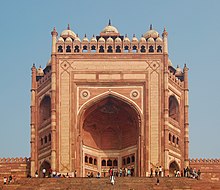
Back Arc Tudor Catalan Tudorbogen German Tudora arko Esperanto Arco Tudor Spanish Tuudorkaar Estonian Tudor arku Basque Arco Tudor Italian Tudorboog Dutch Łuk Tudorów Polish Arco Tudor Portuguese

A four-centred arch (Commonwealth spelling) or four-centered arch (American spelling) is a low, wide type of arch with a pointed apex. Its structure is achieved by drafting two arcs which rise steeply from each springing point on a small radius, and then turning into two arches with a wide radius and much lower springing point. It is a pointed sub-type of the general flattened depressed arch. This type of arch uses space efficiently and decoratively when used for doorways. It is also employed as a wall decoration in which arcade and window openings form part of the whole decorative surface. Two of the most notable types are known as the Persian arch, which is moderately "depressed" and found in Islamic architecture, and the Tudor arch, which is much flatter and found in English architecture. Another variant, the keel arch, has partially straight rather than curved sides and developed in Fatimid architecture.[a]



- ^ Ragette, Friedrich (2003). Traditional Domestic Architecture of the Arab Region. Edition Axel Menges. p. 37. ISBN 978-3-932565-30-4.
- ^ Curl, James Stevens (2006). A Dictionary of Architecture and Landscape Architecture (2nd ed.). Oxford University Press. p. 37. ISBN 978-0-19-860678-9.
Cite error: There are <ref group=lower-alpha> tags or {{efn}} templates on this page, but the references will not show without a {{reflist|group=lower-alpha}} template or {{notelist}} template (see the help page).
© MMXXIII Rich X Search. We shall prevail. All rights reserved. Rich X Search